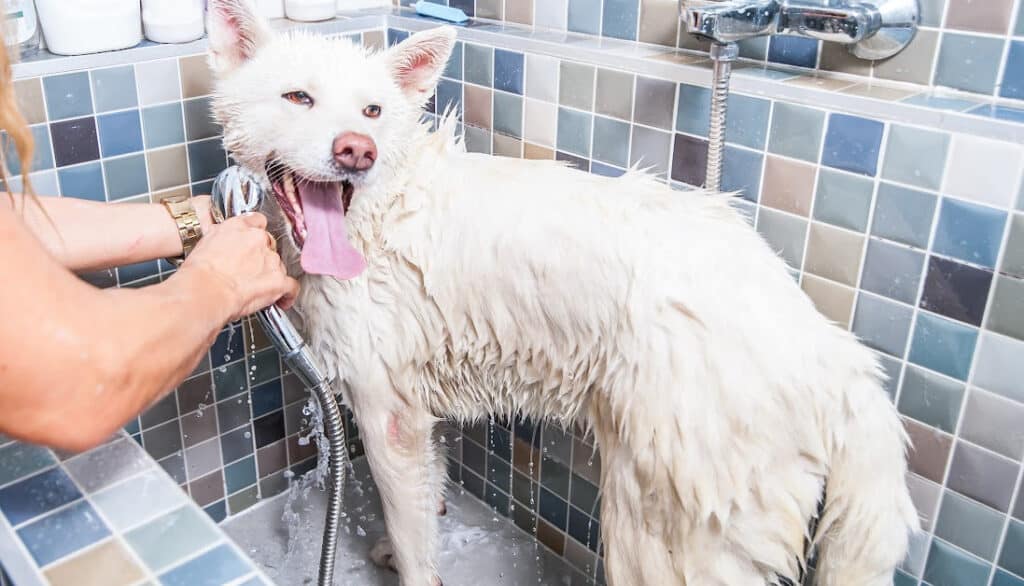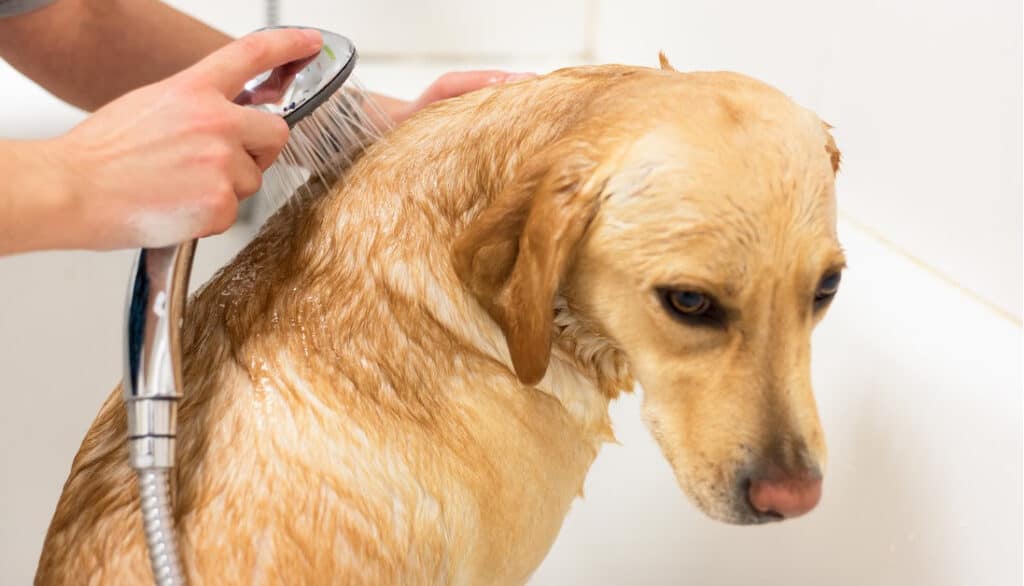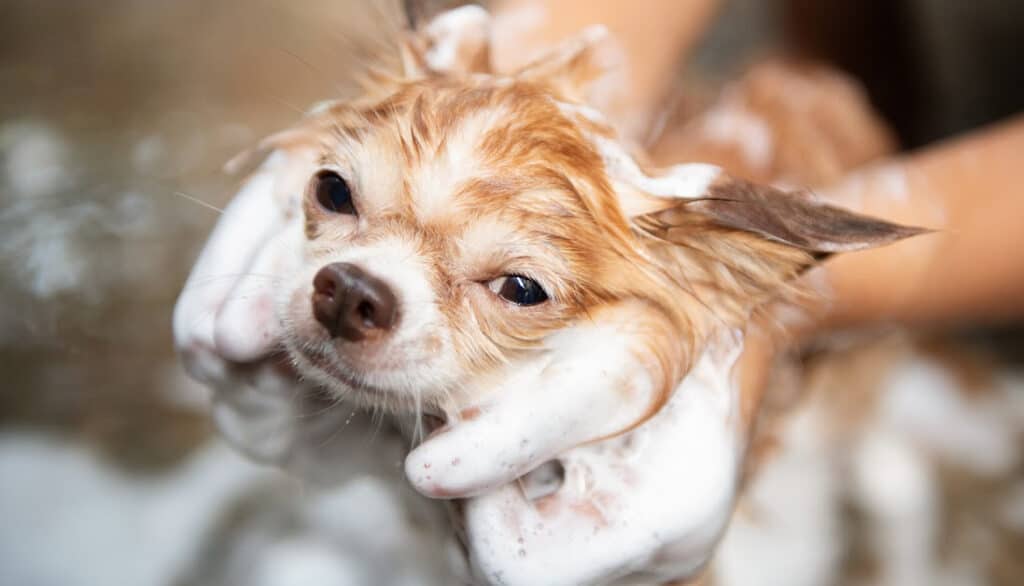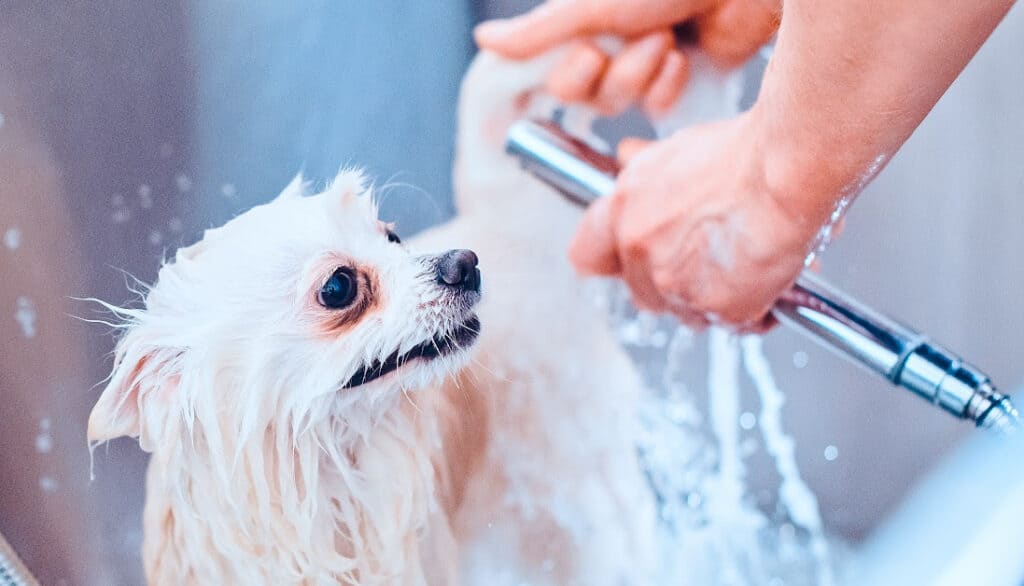We’ve all been there: mid-way through bath time, you reach for your trusty bottle of dog shampoo, only to realize it’s empty. Your gaze shifts to the cat’s bottle sitting nearby, and you ponder, “What’s the harm in using cat shampoo on my dog?” In the vast world of pet care, it’s easy to assume that if two products look similar, they might be interchangeable. But, as any seasoned pet owner will tell you, looks can be deceiving. Pet hygiene, much like our own, is a nuanced affair. Each animal, from the sleek Siamese cat to the boisterous Beagle, has its unique set of needs. This article aims to delve deep into the furry conundrum and answer the pressing question: Can you use cat shampoo on dogs? The short answer is yes, but it should not replace shampoo made for dogs.

The Basic Differences Between Cat and Dog Skin
At a casual glance, the furry coat of your beloved Fluffy and Rover might seem quite similar. After all, they both serve the primary purpose of protecting our pets from environmental elements and keeping them warm. However, when you dig a little deeper (no pun intended), you’ll find that the skin beneath those coats is as distinct as the meow of a cat and the bark of a dog.
1. Skin pH Levels: The first, and perhaps most crucial difference, is the pH level. Cats generally have a skin pH balance that veers towards the acidic side, usually around 6.2 to 7.5. Dogs, on the other hand, have a more neutral pH, hovering between 6.5 to 7.5. This might seem like minute details, but even a slight pH imbalance can make a world of difference, leading to issues like skin irritation or dryness.
2. Sensitivity Variances: Cat’s skin is notably thinner and more delicate than that of dogs. This means that it can be more susceptible to chemicals and irritants. While a dog might seem unaffected by certain substances, the same can’t be said for cats, and vice versa.
3. Natural Oil Production: Both cats and dogs produce sebum, a natural oil that keeps their skin moisturized and their fur glossy. However, the rate and consistency of this production vary. Overwashing or using the wrong products can strip this oil, leading to a lackluster coat and itchy skin.
In the grand tapestry of pet care, understanding these basic differences is paramount. Just as you wouldn’t use a face wash meant for oily skin on a dry face, it’s essential to recognize and respect the distinct skincare needs of our feline and canine companions. And while both deserve the very best, what’s perfect for one might not be for the other.

Ingredients Found in Cat Shampoo
Ah, the back of the shampoo bottle – that place we sometimes venture into when we’re feeling particularly investigative or simply waiting for the conditioner to set. But when it comes to our furry friends, understanding what goes into their grooming products is not just a curiosity, it’s a necessity. Let’s pull back the curtain on common ingredients found in cat shampoos and their implications.
| Ingredient/Component | Description |
|---|---|
| Aloe Vera and Oatmeal | – Not just for smoothies. – Often found in cat shampoos due to their soothing properties. – Helps calm irritated skin and moisturize. – Provides a spa-like washing experience for cats. |
| Essential Oils | – Lavender and chamomile may sound delightful, but not all essential oils are cat-approved. – Cats have a unique metabolic system, making them sensitive to certain oils, which might be benign or even beneficial to dogs or humans. |
| Parabens and Phthalates | – Commonly used as preservatives and fragrances in both human and pet products. – Rising concerns about their potential health effects. – Many cat shampoos now opt for paraben-free and phthalate-free formulas. |
| Lathering Agents | – Responsible for the satisfying bubbles during a wash. – It’s crucial to know that some shampoos use harsh chemicals as lathering agents, possibly not ideal for a cat’s sensitive skin. |
| pH Adjusters | – Incorporated in some shampoos to keep or modify the pH level, ensuring it’s suitable for cat skin. |
To the untrained eye (or paw), one shampoo might look much like another. But, as we’ve learned, the devil is in the details—or, in this case, the ingredients list. So, before we even consider pouring that cat shampoo on our playful pups, it’s crucial to understand the unique blend crafted for feline finesse.

Potential Risks of Using Cat Shampoo on Dogs
Ah, the age-old pet owner’s shortcut: “If it’s good for the cat, surely it’s okay for the dog, right?” While sharing toys or even a sneaky treat now and then might not raise eyebrows, when it comes to grooming products, the story changes. Here’s a look into what might happen when we make our dogs partake in the feline grooming ritual.
1. Skin Irritations and Allergies: Remember the pH difference we chatted about? Using a cat shampoo on a dog can disrupt their natural pH balance, leading to itchy, irritated skin. Dogs might start scratching incessantly, causing sores or hot spots.
2. Over-Drying of the Coat: Cats and dogs have different sebum production levels. Using a shampoo designed for cats might strip away the essential oils in a dog’s coat, making it dry, brittle, and lacking its usual lustrous shine.
3. Inefficacy Against Fleas and Ticks: If you’re using medicated cat shampoo to tackle fleas and ticks on your dog, think again! These formulations are often species-specific. Using one meant for cats might not give your dog the protection they need, leaving them vulnerable to pesky parasites.
In essence, while it might be tempting to simplify our pet care routine, it’s essential to remember that our feline and canine companions are not just two sides of the same coin. They are distinct, with unique needs, and deserve products tailored just for them. Next time you find yourself reaching for that cat shampoo during Rover’s bath time, think twice – it’s always better to be safe than sorry.

Importance of Specific Formulations
Every pet owner wants the best for their furry friend, especially when it comes to grooming and overall well-being. Dive into any pet aisle, and you’ll quickly realize the sheer variety of products available for different needs. But is this just a marketing gimmick, or is there a real reason behind these specific formulations?
The truth is, tailored formulations matter — and here’s why:
Skin pH Balance
- Cats: Felines typically have a skin pH balance of around 6.2 to 7.5.
- Dogs: Canines, on the other hand, vary between 5.5 to 7.5 depending on the breed.
Using the wrong formulation can disrupt this delicate balance, leading to skin irritations, dryness, or infections.
Unique Skin and Coat Needs
Different pets have different coat types, each with its unique requirements:
- Short-haired pets might require shampoos that focus on deep cleaning, as their skin is more exposed.
- Long-haired breeds benefit from moisturizing and detangling formulations.
- Curly or wiry coats might need specialized products that maintain their natural texture and luster.
Allergies and Sensitivities
Pets, much like humans, can have allergies or sensitivities. Some dogs might be allergic to common ingredients found in general pet shampoos. Hence, hypoallergenic or sensitive skin formulations can be a godsend for these pets, reducing the risk of adverse reactions.
Age-Appropriate Care
Puppies and kittens have different skin and coat needs compared to their adult counterparts. For instance:
- Puppy shampoos are often milder and gentler.
- Adult dog formulations might focus more on deep cleaning or maintaining coat health.
- Senior pets might need shampoos with added moisturizers to combat dryness.
Health Conditions and External Parasites
- Medicated Shampoos: Pets with fungal infections, eczema, or other skin conditions might need medicated solutions to address and alleviate their problems.
- Flea and Tick Shampoos: These are specifically formulated to combat and prevent external parasites, a common concern among many pet owners.
Environmental Considerations
The environment in which a pet lives can influence the type of grooming products they need:
- Dry Climates: Pets might need moisturizing shampoos to prevent skin from drying out.
- Humid Climates: Anti-fungal or deep-cleaning shampoos can prevent infections.
Understanding the importance of specific formulations isn’t just about giving your pet the spa-like experience (though they certainly deserve it!). It’s about recognizing their unique needs and ensuring that every bath, brush, and grooming session contributes positively to their overall health and happiness. So, the next time you’re browsing the pet aisle, remember that those specific formulations are more than just fancy labels — they’re tailored love in a bottle.

Safe Alternatives for Dog Grooming
Let’s face it: anyone with a furry friend has, at some point, stared at a muddy, happy dog and sighed, “Bath time again?” And while we’ve debunked the myth of using cat shampoo for our canine pals, the good news is there are plenty of alternatives tailored just for them. Let’s fetch some insights on safe and effective grooming options for our tail-wagging buddies.
Dog-specific Shampoos
Starting with the obvious, dog shampoos are formulated with a dog’s unique skin and coat needs in mind. Whether your pup has a thick double coat or curly waves, there’s a shampoo out there ready to give them the pampering they deserve.
DIY Dog Shampoos
Feeling a bit crafty? There are numerous homemade shampoo recipes that use natural ingredients like oatmeal, coconut oil, and baking soda. They’re gentle, effective, and you’ll have the peace of mind knowing exactly what’s going on your dog’s skin.
Waterless Dog Shampoos
For those days when you don’t have time for a full-blown bath or for dogs who detest water, waterless shampoos come to the rescue. They’re easy to apply, require no rinsing, and leave your dog smelling and feeling fresh.
Medicated Dog Shampoos
If Fido has specific skin conditions like eczema, fungal infections, or flea infestations, medicated shampoos are a godsend. However, always consult with your vet before choosing one to ensure it’s the right fit for your dog’s condition.
Conditioners and Leave-in Sprays
Much like our hair, sometimes a dog’s coat needs a little extra TLC. Dog conditioners can help detangle, moisturize, and add a glossy finish. Leave-in sprays, on the other hand, can provide a quick touch-up between baths, keeping that ‘just groomed’ look going a bit longer.
Regular Brushing
Often overlooked, regular brushing is a cornerstone of dog grooming. It helps distribute natural oils, removes dirt and debris, and is a fantastic bonding activity. Plus, with the right brush for your dog’s coat type, you’ll reduce shedding and matting.
In the ever-evolving world of pet care, one thing remains constant: our undying love for our canine companions. And part of that love involves ensuring they look and feel their best. So, whether you’re reaching for a store-bought solution or whipping up a DIY concoction, remember: the right grooming routine can make all the difference in your dog’s health and happiness.

Conclusion
Stepping back and surveying the landscape of pet care, it’s crystal clear that the decisions we make, even the seemingly minor ones like choosing a shampoo, ripple through the lives of our furry friends. Cats and dogs, though they might both grace our living rooms and commandeer our beds, have unique intricacies that deserve recognition and respect. The takeaway? Using cat shampoo on dogs is much like trying to fit a square peg into a round hole; it’s just not the right match.
But, as we’ve journeyed through the world of pet grooming, one thing shines brighter than a freshly bathed pup under the sun: our commitment to their well-being. Armed with knowledge and a heart full of love, we can make choices that keep our pets both dazzling on the outside and joyful within.
So, the next time you find yourself standing in the pet aisle or staring at your muddy dog after a playful romp outside, remember this guide. Let’s cherish every splash, lather, and brush stroke, ensuring that our pets receive nothing but the best, tailored to their individual charms. After all, isn’t that what our four-legged family members truly deserve?
Frequently Asked Questions (FAQs)
While it might be tempting, it’s best to avoid using human shampoo on dogs. Like cat shampoo, human shampoo might not align with the pH level suitable for dogs and could contain ingredients that irritate their skin.
The frequency depends on your dog’s breed, lifestyle, and specific needs. While some dogs might need a bath every week, others could go a month or more without one. Observe your dog’s skin and coat, and consult with your vet or a professional groomer to determine an optimal bathing routine.
Don’t panic! Rinse your dog thoroughly with plenty of water to remove all traces of the shampoo. Monitor them for any signs of skin irritation, discomfort, or allergic reactions. If any adverse effects appear, consult your vet promptly.
Yes, some breeds with thinner or less oily coats, like the Chinese Crested or the Xoloitzcuintli, might have more sensitive skin. Always choose a shampoo tailored to your dog’s specific needs, and when in doubt, ask your vet for recommendations.
Absolutely! There are many dog-specific conditioners available that can help detangle, moisturize, and add shine to your dog’s coat. Just make sure it’s formulated for dogs to ensure safety and effectiveness.
